|
|
|
|

The Plentitude of Emptiness: Collected Haibun by Hortensia Anderson. Published by Darlington Richards, spring 2010. Introduction by Jim Kacian. Available for purchase at http://www.lulu.com/product/paperback/the-plenitude-of-emptiness/6484337 Perfect bound, 8.5 x 5.5 inches, 138 pages. $10.73 plus postage.
“This really is a must-read collection. The haibun are potent and profoundly moving. My thanks and congratulations to the publishers! This is truly an important work.” Denis Garrison.
I had been putting off ordering a copy of Hortensia’s book, The Plentitude of Emptiness, until I read Denis’s recommendation and at the same time Lulu had a one-day promotion of free shipping. After the speedy arrival of the book when I could actually begin reading Hortensia’s haibun I had a feeling of regret for all those days I let go by without having the gift of her words in my heart.
For only the second time since I have been reading haibun did I find the big word “Yes!” welling up within me as I read. At first I was simply carried away into Hortensia’s world and delighting in the way her mind culled and accepted the information she brought from her memories. The way the prose complimented, enlarged, and resounded against the haiku fascinated me. How did she do it? She makes haibun sound so natural. So easy to do.
Enough other authors who strain to be innovative wordsmiths have proved that writing haibun prose is not easy, natural, or successful. Hortensia takes their failures, brushes them with light, and creates something new on each page.
I have tried to read Hortensia’s haibun with a critical discerning eye but I cannot. Again and always, the flow of her words and the intense images they allow me to create pull me under and away into a riptide of emotions.
Here is a sample of Hortensia’s haibun:
Recurrance
You haunt my days because you live in my nights. I wonder if death rotted you away to parchment on bone. I knew nothing lasts forever. I didn’t know only nothing lasts forever.
buried
in a second snowfall –
blue crocus
See how the most excellent haiku is deepened and enriched by the thoughts and information in the prose? Notice how the prose reads like poetry? Acknowledge the leap of understanding within the ideas? Add that to the haiku and you truly have a new and richer poetry form.
There is immense wonder for this woman who endures such pain and bodily frailties in order to stay alive to bring us such gifts. There is thanksgiving for her steel center that raises her above the darkness and terror to a place of light, and joy where she nourishes her ability to bring that to the printed page.
The book is truly a global effort. Hortensia lives in New York. Norman Darlington in Ireland and Moira Richards in South Africa edited and produced the book. And readers anywhere in the world can order the book directly from Lulu.com at an extremely reasonable price – far too low for such a treasure.
As Jim Kacian writes in the Introduction: “If haibun didn’t exist, it’s possible that Hortensia Anderson would have had to invent it.” I think she did.
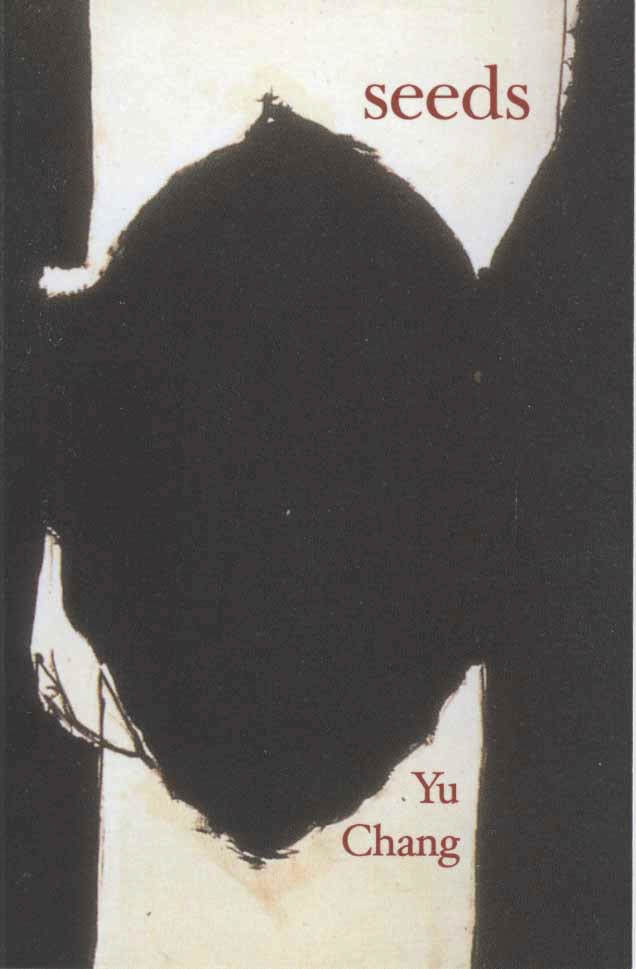
seeds by Yu Chang. Red Moon Press at www.redmoonpress.com: 2009. Perfect bound, 6.5 x 4.25 inches, unnumbered pages, $12.
If one could make a stack of all the haiku books published since 1966, above its wobbling, one would have to make a secure space at the top for Yu Chang’s book, seeds. It has been so long since a simple book of just haiku has pleased me this much! It is not really a surprise since I have admired the person Yu and the writer since he first began posting his haiku on the Shiki Internet Salon in the middle of the 1990s.
The surprise is how well the book carries Yu’s abilities in not only the single haiku, one to a page, but to the graphics and typography. The title, seeds is supported by the selection of a section of Robert Motherwell’s famous painting, “Elegy to the Spanish Republich No. 134” that shows – a seed. This image is repeated in muted grays as division pages for sections – not your same old seasonal references – but titled “fog,” “edge,” “barefoot,” “closer,” “directions,” and “tug.” I find these delightful! The book does have an overall order with the first haiku being:
small town
my accent starts
a conversation
and the last one:
fallen leaves
do I have to
go home
From this small sample you can surely surmise the excellence of Yu Chang’s haiku. Each one is a gem that has been marvelously conceived but then polished and reconsidered until it is as perfect as a haiku can be. In true haiku tradition, the work in Yu’s book gets better with each reading. For anyone thinking of making a book of their haiku, I would recommend buying this book and studying it well. It is an excellent example of the genre!
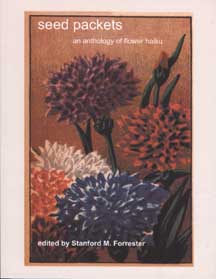
seed packets: an anthology of flower haiku edited by Stanford M. Forrester. Bottle Rockets Press: 2010. Stanford M. Forrester, P.O. Box 189, Windsor, CT 06095. Perfect bound, color cover, 6.5 x 5 inches, 193 pages, 126 poets, 266 haiku – and as the professional info tag claims: some sun, some sky, some earth, some water and some seeds – all for $17, plus shipping. Contact: www.bottlerocketspress.com.
According to Stanford Forrester, in the Introduction, the word ‘anthology’ comes from the Greek, meaning “gathering of the flowers of verse.” Since he cannot actually get the flowers into the book, he calls the collection seed packets to convey the idea that the haiku are the seeds that can only flower in the mind of the reader – a lovely thought – fitting for such a collection.
And a collection it is. With 126 haiku writers from around the world, seed packets becomes a who’s who of haiku and Forrester has done a good job picking the best of the flower poems each has written. Each poet has one to four poems picked. Only Michael McClintock had five. All of the poets with four poems in the book were males with the exception of Ruth Holzer. The rest had one to three. Though the gender divide was equal among the poets, more males had more of their poems accepted than the women.
But you guys could be saying, “what about the haiku?” They are excellent and mostly devoid of gender – meaning they are universal as they should be. Forrester is a professional editor and the pages of poems declare this with the perfect spacing, the lack of caps and minimal punctuation, and the perfect haiku shapes for the most part. He goes to the trouble of tracking and giving acknowledgements for each poem used which is usually a thankless job and easily overlooked.
This IS bottle rockets press’s fifteenth book and I think is the largest one so far. The book, seed packet, is an enormous undertaking and offers so many haiku for pleasure and for study, I would highly recommend your buying the book even if your haiku are not included. And if they are, buy more books for friends and family to show what haiku can do and be.
I opened the book just to pick a sample and turned to pages 108 and 109 where I found Susan Constables’s
:
first snowdrop
the woodpile
looks smaller
along with Peggy Willis Lyles’s haiku:
the scent
of paperwhite narcissus –
an unfinished dream
Alone on page 109 was Robert Epstein’s:
flowering narcissus
I do not feel
myself today
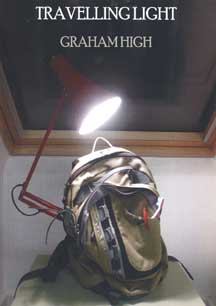
Traveling Light by Graham High. Ram Publications, 12 Eliot Vale, Blackheath, SE3 OUW or order from Graham High, Bluebell Barn, Gresham, Norfolk, NR11 8RN, United Kingdom or highsculpt (at) btinternet(dot) com. Perfectbound, 8.5 x 5.5, 92 pages, £7.
After reading Traveling Light I feel I have no words of my own. I have nothing that belongs to me. I have given everything – all my thoughts, feelings, and impressions – over to the strange creature on the cover of this book who has stolen my soul.
Abduction by extra-terrestrials? How can I ever stop thinking that the face on the cover might once have been a backpack? Traveling light or a light for traveling? Yes, I have been taken on a trip even though my body hangs in this desk chair – limp and pliant. Dreamy. It is especially easy to doze in English country places. Why do country sides become beds for brains? Are plants our thinking bodies and flowers the sex lives we are willing to contemplate?
Brain washing by haibun? I think so. At least I am in a world of great peace and the guy in the canoe is a professional – Graham High. How fortunate we are that a writer of his skill and soul of his depth has taken an interest in both haiku and haibun to take us on his journey.
In the very professional press release accompanying the book is the line: “A life-long writer of poetry, this is his first collected departure into haibun.” “Departure” – why the word departure? What did he leave in order to write this book? Poetry? Maybe in the oldest usual sense? But you cannot leave poetry. Maybe it can leave you (as I am feeling now) but no one escapes after having walked off the edge of the world.
Perhaps because Graham High is using a poetry form that is not in the dictionary? That tidbit of information tickles and teases me as it rolls from wall to wall in my empty brain pan. Maybe my head really has turned into a nylon face-colored rucksack with a zipper mouth that hangs open by a clipped pen? Would you read a book review by Northface?
traveling light
carried along by loss
and found
What happens when words become putty and fingernails? Can anyone make a peanut butter sandwich without lifting a foot? Only a ticking clock. Or the reality of cat toys.
Lest the reader thinks this is the way Graham High writes here is a sample of the real thing:
“
wind long the beach
an abandoned shoe
slowly fills with sand
Everyone comes here from time to time. Everyone needs to be alone. It soothes the mind to be among sea and stone. You can lose yourself between the endless and the particular, but a random focus on a single unusual pebble can absorb all consciousness of your own existence.
sea-pierced stone –
getting down close to hear
what it makes of the wind
I stare at the sea for a while. But contemplation too is an event in time. There is only so much meditation one can take before a certain restlessness cuts in: a compulsion to action. Almost automatically I find myself making a choice. A pebble seems to slide itself into my hand. I focus on the casual knack of throwing stones in water.
my single pebble
spinning over waves that tumble
every pebble
I become absorbed in it. Each stone more carefully selected. I begin to scour the beach assiduously looking for the perfect stone, round and flat; fitting my fingers exactly, just the right weight. At each throw I count the skips; see where each ends up; where each disappears.
as if casting
rune stones into the sea –
each pebble has its mark
And from that focus other thoughts are freed; dilemmas can be resolved; emotions stilled; losses can find closure.
skimming across the sea
as I think of you –
memorial stone
And so the afternoon passes. The sea has moved its boundaries. I move higher up the beach. I have a desire to creep closer; to link with stone and water further. I take off my shoes and socks and pick my way down the shingle to the sea.
the sun’s horizon –
under the sea a pebble
shifts beneath my foot”
I had planned to only type in an excerpt of that piece, but as I went I discovered how ‘rounded’ it was and that the beginning really did need the ending. Also I was impressed how Graham used the semi-colon to give his sentences the shortness one finds in Emily Dickinson’s poetry (with dashes) that makes the prose very poetic. Good idea and sound (in every sense of the word) practice.
The piece that really made my skin prickle was “War Games.” You can buy the book to read that one. Go ahead, buy a book of poetry. Make his day. Find yourself.
~*~
My horoscope for the day: “Weak, transient effect: This influence can signify a critical time in your communications with the people around you, particularly those with whom you are intimately involved. The danger is that your feelings and emotions will overwhelm your rational intellect, making your thinking so subjective that no one else will be able to relate to what you say. Nevertheless you have a strong need to communicate about your emotions. You should avoid dealing with controversy by changing your own views every time someone disagrees with them. You will tend now to change your views according to the prevailing wind, but this may result in compromising yourself if the people you have "agreed" with compare viewpoints. However, it is natural for your opinions to be in a state of flux at this time. Just be honest about admitting it.”
~*~

Fereastra moastra / Our Window by Dumitru D. Ifrim. Editura Universitara: 2009. Romanian and English. Flat-spine, color cover, 8.5 x 5.5 inches, 50 pages. Contact: Clelia Ifrim, Calea Dorobantilor 135-145 / Ap 5, 010563 Bucharest, Romania
Dumitru Ifrim is an international lawyer and Director Counselor at the Senate of Romania and has published seven previous books of poetry. As well, he has been awarded several important Japanese prizes, for his haiku. One was the Iga Town Prize in 2002 for
Wounded by bullet
a deer continues her jump –
sunset of winter
But I liked:
Beautiful orchard –
I gather the summer past
from the ripe pears
Haiku is making an important jog in the road. In the beginning writers designed their haiku around the examples of translated Japanese haiku, and we got very good at that. Now poets, like Ifrim and Graham High, are coming to haiku after years of poetic exercise and they bring a new sensibility to the form. It is subtle but it is like the light is coming around a corner or is reflected by a smooth surface. The haiku are not mirrors but glass that collects images in facets. Words are failing me. I want to tell you what I find special in this book yet all I can do properly is to hold out the book and say to you, “Look at this. Read it. Take these poems into yourself and see what you think.”
End of the autumn –
a last leaf is flickering
together a thought
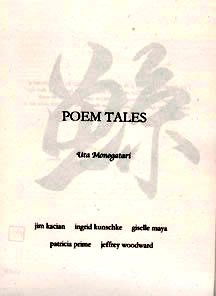
Poem Tales: Uta Monogatari by Jim Kacian, Ingrid Kunschke, Giselle Maya, Patricia Prime, and Jeffrey Woodward. Koyama Press, 84750 Saint Martin de Castillon, France: Year of the Tiger. Hand-tied, hand-made paper covers, 14 x 10 inches, calligraphy by Isabelle Baticle. Contact: Giselle.Maya (at) wanadoo(dot)fr
Poem Tales: Uta Monogatari is the 16th book done in the tradition of Japanese poetic forms by Giselle Maya in a small village perched on the side of a mountain in southern France. Maya makes no attempt to position her books as trade paper backs for stores but depends on the support of book lovers. As print-on-demand companies proliferate her hand-made books become even more rare.
As editor and poet (and artist and gardener) Giselle does publish excellent works by very good writers. For Poem Tales: Uta Monogatari she brings Jeffrey Woodward, editor of Haibun Today; Patricia Prime, co-editor of the New Zealand haiku journal Kokako; and Jim Kacian, editor of the Red Moon Press and Ingrid Kunschke – a very impressive collection of international haibun writers.
The tales, with varying degrees of story-telling, center around an animal and on the pages between are the hand-brushed kanji so that while one reads on one page, the kanji soaks into the peripheral vision so one feels as if really reading Japanese. Due to Giselle’s years of living in Japan and studying Japanese Literature at Harvard, her books have a strong emotional and intellectual tie to the land of inspiration for haibun, haiku, and tanka.
The haibun by Giselle Maya and Patricia Prime are the most tale-like and actually do tell little stories in the conventional way. Ingrid Kunschke puts herself into the animal or plant to tell a story (with lots of questions) from that angle. Jim Kacien uses a cool detached method of describing an encounter from the human standpoint. Jeffrey Woodward’s haibun are tiny glimpses of a single moment, very haiku-like, out of an experience. In contrast Woodward’s haiku are not the torque points but attempt to continue telling a story.
Jeffrey Woodward
Unbridled
she leans on his neck
patiently, but the stallion
confesses nothing
Only, rising from his nostrils, that white breath that mingles with hers, there before the stable this frosty morning, when the wild, bright eye blinks largely with a semblance of apprehension –but of what? –and she, unloosening her hand from his main, departs.
the thoroughbred
forgets a fence and canters
in a withered field
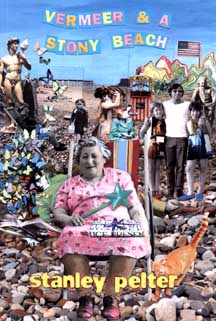
Vermeer & A Stony Beach by Stanley Pelter. George Mann Publications, Easton, Winchester, Hampshire SO21 1ES, United Kingdom. Perfect bound, 8.5 x 5.5 full color cover, 170 pages, some with color illustrations by Pelter, £8.
Of the five books of haibun +++ by Stanley Pelter, Vermeer & A Stony Beach is far and above my favorite. Maybe I have learned to read and appreciate haibun – over half the books to be reviewed in this issue attest to its popularity – but it could also be that reading Pelter’s down-to-earth nitty-gritty style of observing and writing is such a refreshing change from the prissy, classroom copies of what literature once was that comprises so much of haibun today.
I have the feeling that Basho, coming back today from the withered fields to which he went in 1694, would read Vermeer & A Stony Beach saying to himself, “Kokode bunchou hoshii nasu haibun.” (That’s what I wanted to write with haibun). Basho too took a highly stylized poetry form – prose and tanka – from travelogues and tales, and brought it up-to-date with colloquial language and modern – for the late 1690s – concerns of the contemporary author to create haibun. Now four hundred years later, and a culture away, we do need to reinvent the form. Pelter is making an honest attempt and it is such a joy to read after the safe little glimpses of a pristine life.
Pelter has some very fascinating stuff – his life growing up in an impoverished wartime childhood with parents, though poor, who instilled him with a sense of the best the culture could give. That dichotomy is almost enough for several more books. Pelter is fearless in exploring and explaining every part of his life and his self. The fact that he chooses to use the (usually) tame poetic form of the haibun adds another twist to the multi-leveled stories. As if that were not enough, Pelter is also an artist with his way with images similar to the way he writes. It is as if levels are piled on layers and only the insensitive could fail to find something remarkable.
Izzy Sharp, who makes the marvelous collaged covers for all of Pelter’s books, writes an introduction for Vermeer & A Stony Beach that I wish I could bring here – all ten pages. Sharp writes so much of the right things about Pelter’s life and writing – ideas and impressions you as a reader can use if you wish to analyze the book. Otherwise, if you are the kind of reader who only reads introductions as a final act, you can simply jump in, allow yourself to sink to the top of the pages to just read and enjoy.
salt of the earth
(excerpt)
saw a daffodil
unfurl before it explodes
reason blows away
You’re a right difficult bastard. You know that, don’t you?
Maybe. No. Just am what I . . .
You’re difficult. Can’t understan’ yer clever-dick writin
Don’t feel it. Just am what I am. That is all there is to it.
You’re difficult.
If you say so.
Wish I knew. Don’t
For heaven’s sake why not?
Why for heaven’s sake?

Familiar & Foreign: Haiku & Linked Verse by Richard Tice with Jack Lyon & Others. Waking Lion Press available through Amazon.com. Perfect bound, 6 x 9 inches, 66 pages, US$7.95
Old-timers will remember Richard Tice because he was editor of the last 16 issues of Dragonfly – the haiku quarterly started by Lorraine Ellis Harr. At the time he published Station Stop: A Collection of Haiku and Related Forms (Salt Lake City: Middlewood Press, 1986) which won second place in the HSA Merit Book Awards and sold very well. Then Tice seemed to disappear from the haiku scene. Seven of those years were spent teaching English in South Korea. Now he is back and publishing again. Concurrently being released with Familiar& Foreign is his book of poetry, Degrees of Light. He is currently teaching English Composition in Bay Area colleges.
Familiar & Foreign is instructive in the way all books using Japanese genre poetry used to be. Having lived, and also taught, in Japan Richard Tice is very accurate and writes in such a pleasing manner that one doesn’t mind having to read it all again. One can always hope that it will be his book that makes the cross-over and is accepted by mainstream poets.
Familiar & Foreign opens with a selection of Tice’s haiku prefaced by an account of how he experienced one of the haiku and gives a blow-by-blow account of how he narrowed the inspiration into the final three lines.
different tones
of nuts as a woman
shakes a bare gingko
After pages of single haiku, Tice offers the haiku in sequences which segues into the linked verse (which thankfully he does not call renk*). The first one is “Skull Valley” (published in Lynx) with Jack Lyon which shows the easy camaraderie between two who have written together for many years. Reading through it I can see and feel the pages of Dragonfly before me. Like a fly in amber, Tice retains the patterns and images of Lorraine’s many renga.
From the Tanrenga section:
New Year’s Day –
finding last year’s
resolutions
Jack Lyon
in the gravel pit, nothing
but falling snow
Richard Tice
The most interesting teaching work is the final one in which he creates a renga from the haikai written by Basho and his students – Boncho, Richiya, and Kyorai with Tice’s arrangement and translation. For me it was not clear if the links were actually written by these men 400 years ago or if Tice wrote them all. The wakiku is by Basho but the rest seem made up. Tice writes of being inspired by a Jack Spicer homage to Lorca in which one cannot tell where Lorca ends and Spicer begins and one has to admire Tice’s skill in writing both the Japanese and the English.
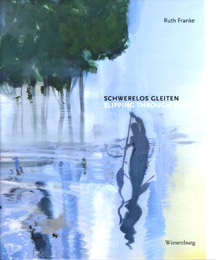
Schwerelos Gleiten / Slipping Through Water, by Ruth Franke. 2010,Wiesenburg Verlag, bilingual – English/German. Hardcover, 120 pages, 9.5 x 8 inches, $ 19,95. Distribution.: Red Moon Press, P.O.Box 22461, Winchester, VA, 22604-1661, U.S.A.
Everything in Schwerelos Gleiten / Slipping Through Water becomes a leitmotif for a reading audience who is open to the acceptance of a symbiotic relationship between prose, verse, and picture. The many-layered poetry of Ruth Franke, in German, further combined with the addition of the English versions by David Cobb and Celia Brown, and an introduction by Jim Kacian, reveal the depths of the meanings hidden in this tour de force. Pictures of Reinhard Stangl’s paintings are then integrated to guide us into a parallel world.
Ruth Franke’s poetry sharpens our comprehension and appreciation for the “link and leap” and smoothes the way for the understanding of a new genre in contemporary literature. From the dust jacket flap by Werner Reichhold.
Schwerelos Gleiten / Slipping Through Water, der Buchtitel ist Leitmotiv für Leser, deren Aufnahmebereitschaft offen ist für eine Symbiose von Prosa, Vers und Bild. Die vielschichtig ausgeloteten Arbeiten von Ruth Franke und die als selbständige Sprachgebilde zu lesenden Übertragungen von David Copp und Celia Brown potenzieren sich gegenseitig. Stangls Bilder sind als visuelle Parallelwelt integriert.
Ruth Frankes Dichtung sensibilisiert unser Bewußtsein, veranschaulicht ``Verbindung und Sprung``, ``link und leap``, und ebnet den Weg hin zum Verständnis einer neuen Spielart von Literatur der Gegenwart.
Schwerelos Gleiten / Slipping Through Water is a beautifully made book. Not many people do a hardcover with dust jacket, and have full-color illustrations. The haibun are excellent. See "The Galoshes of Fortune" in the solo poetry section. Do not miss this very special book!
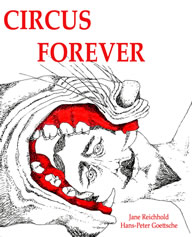
Circus Forever by Jane Reichhold und Hans-Peter Goettsche.. Perfect bound, 10 x 7 inches 86 pages, AHA Books 2010. ISBN 978-0-944676-28-6, Preis $18,-
Reviewed by Gerd Boerner in German for Somergras – the journal of the DHG
"Come on in!" – in this case it is not an invitation into a circus tent, but the magic world of a book, from two artists – Jane Reichhold and Hans-Peter Goettsche, that was published in February of this year. I immediately Googled Goettsche and found his many sculptures.
Without knowing the sculptor we had already laid in the sun beside the „Lesenden Knaben“ (Youth Reading) in a Berlin park and at a class reunion at my high school I had marveled at the work „Mädchen“ (Young Girl). In addition to his work as sculptor, Goettsche is also known through his illustrations in pen and ink for the children's books by James Kruess. I talked with Hans-Peter Goettsche, who now lives in Berlin-Koepenick, near his sculpture „Reiherbaumes“ (Heron Tree). He said his drawings hold so much more than he could say.
However Jane Reichhold, author of many haiku, tanka and renga books explains the "more" in a wonderful poetic way. Her short poems do not describe Goettsche's drawings, but lead the reader to new associations. Here you can see an example of the art of this collaboration:
balance act
with a crash of glass
a slight breeze
small and whispered
sunshine on a cloudy day

With wonder we ask the magic trick: Where does the wind blow the unseen and the unreachable?
Shall I laugh or cry at the clown in us in the end? As long as we, like artists on the trapeze of life, with each catching the sun and our thoughts while flying away, we celebrate our being.
clown’s old car
papa doesn’t laugh when
it falls apart
the swollen throat
still within the egg
Our life is a circus and there is always a hint of madness in a managery when a trained bear rolls a barrel around the ring and his scary claws reminds one of Grandpa's softly haired hands.
scary bear claws
soft and hairy
Grandpa’s hand
between acts
a shimmer of madness
plays in the ring
At sometime then the circus night ends and that means that we must leave the very special smell, the glitter under the tent top to go home. What remains of the fascination of a world, that Jane Reichhold, transports us over the art and endlessness of our lives so exactly and with such humor. Her tanka and haiku, with the drawings from HP Goettsche in this book, Circus Forever, are clearly a deep pleasure in which we find the spectacle of our lives in all its facets..
circus time
in the autumn sky
red leaves
in adoration of sparkle
knowing to go home
early morning light
the trampled grass circle
where all was
BOOK ANNOUNCEMENTS
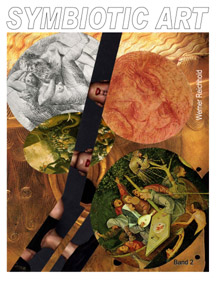
Symbiotic Art, Book 2, by Werner Reichhold, 2010. 8,5:11", 96 pages,
77 pages in full color. ISBN: 978-0-944676-88-2. $ 25,- post paid.
This second book represents a continuation and an extension of the collage series presented in Book 1. The collages in Book 2 include more social aspects important to artists during the past centuries. Also new and therefore enlarging the former aspects of collage is the integration of picture and poetry in some of the works. If you liked the first book, Band 2 will continue the surprise and delight.
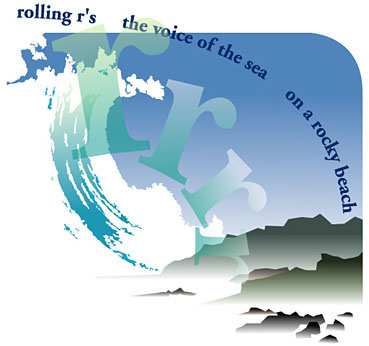
Kuniharu Shimizu, is the well-known artist who creates computer art haiga with the haiku written by everyone who is anyone in the haiku world. Now he has created two e-books – collections of haiku on a theme. One is water and the latest one is wind. You can purchase them at:http://tfship.net/bookstore/bkstore.html
Wind contains the works of: Matsuo, Basho (Japan). Peter Yovu (USA), Peggy Willis Lyles (USA), J.W. Hackett (USA), Kaneko, Tohta (Japan), Catherine Mair (New Zealand), Alan Summers (UK), Kobayashi, Issa (Japan), Jim Kacian (USA), Fay Aoyagi (USA-Japan), Iijima, Haruko (Japan), Cor van den Heuvel (USA), A.C. Missias (USA)
John Bird (Australia), Martin G. Cohen (USA), Alenka Zorman (Slovenia), Linda Robeck (USA), Yamaguchi, Seishi (Japan), Višnja McMaster (Slovenia), Darko Plazanin (Croatia), Jane Reichhold (USA), Kuniharu Shimizu (Japan), Kornelijus Platelis (Lithuania), Andres Ehin (Estonia), Sonia Sanchez (USA), Casimiro de Brito (Portugal)
Lidmila Balabanova (Bulgaria), Drago Štambuk (Croatia), Natsuishi, Ban’ ya (Japan)
Mehdi Laquanbi (France), Connie Donleycott (USA), Sakaishi, Kanon (Japan), Ruth Yarrow (USA), Michael Dudley (Canada), Ai Li (UK), Edin Saračević (Slovenia),
Micheal Clintock (USA), Ellen Compton (USA), Vladimir Devidé (Croatia), Nagata, Koi (Japan), Iwabuchi, Kyoko (Japan), Marili Deandrea (Italy), Sue Mill (USA), John Wills (USA), Robert Spiess (USA), Earnest J. Berry (Australia), Paul David Mena (USA), Alexis Rotella (USA), Alan Pizzarelli (USA), John Brandi (USA), Robert D. Wilson (USA), Rita Summers (USA), Bruce Ross (USA), Christopher Herold (USA), Taneda, Santoka (Japan), Sumitaku, Kenshin (Japan), J.D. Heskin (USA), William J. Higginson (USA), Polona Oblak (Slovenia), Juanito Escareal (USA- Philippines), John Sandbach (USA), paul. m (USA), Yasui, Kohji (Japan), Yosa, Buson (Japan), Chiyoni (Japan)
The Time of This World: 100 tanka from 13 collections by Kawano Yuko, translated by Amelia Fielden & Saeko Ogi, Published by MET Press Trade paperback. 44 pages, 6" x 9", perfect binding, 60# cream interior paper, black and white interior ink, 100# exterior paper, full-color exterior ink. This book is available from ww.Lulu.com/modernenglishtanka. Information is available online at www.themetpress.com Price: $9.95 USD. ISBN 978-1-935398-15-8.
The Time of This World contains translations by Amelia Fielden and Saeko Ogi of 100 tanka selected from 13 of Kawano Yuko's major collections, ranging from the passionate love lyrics of her earliest book Like a Forest, Like a Wild Beast, to the thoughts of a young mother living temporarily in the USA; from the mature reflections of My Tanka Diary, to The Maternal Line, where she is confronting the death of her mother, and the resurgence of her own cancer.
Kawano Yuko, highly-acclaimed professional writer and teacher, is married to the scientist and poet Dr Nagata Kazuhiro; they have a son, a daughter, and four grandchildren. Living in Kyoto, the traditional culture capital of Japan, Kawano and Nagata lead the prestigious Tower association of contemporary tanka writers, and publish its monthly journal of the same name. Kawano Yuko stands in the forefront of Japanese post-war women tanka poets. An intensely personal writer who always enlivens her poetry with events from her own life, Kawano has had a long and distinguished career spanning 40 years. She has published books of essays & criticism. During her many years as a high-profile professional poet, Kawano has taught tanka composition at community colleges and on television, lectured all over Japan, and served as a judge for many tanka contests.
From Shelter | Street:Haiku & Senryu by Karma Tenzing Wangchuk
Minotaur Press is bringing out a 32 page chapbook featuring the poetry of Karma Tenzing Wangchuk. This book is at present available only by pre-order. Pre-ordered copies will be available in Mid-March. They may be received at a book party in Mid-March, or you may have your copies mailed. You may pay when ordering or pay when billed at time of publication.
Some of the poems in this collection first appeared in Beachcomber, bottle rockets, Dozen, Farming Chapbook, Frogpond, Heron's Nest, Inquiring Mind, Lilliput Review, Lynx, Mann Library's Daily Haiku, Minotaur, Modern Haiku, Moonset, Parnassus Literary Journal, Stylus, Raw Nervz Haiku, Seed Packets, Simply Haiku, Stone Buddha, http://www.tinywords.com, Turning Wheel, and Willow Street.
Karma Tenzing Wangchuk was born in Los Angeles and has spent most of his life in the American Southwest, with stretches in northern California, New England, the Far East, Greece, and Mexico. An ex-Buddhist monk, Tenzing is the author of several poetry chapbooks including 90 Frogs (1999), Clouds Gather and Part (2003), and Stone Buddha (2009). Since Spring 2006, he has lived in Port Townsend, Washington, where he can often be found reading in open-mic at The Boiler Room on Thursday evenings and at Lehani's Deli & Coffee House on Fridays. Minotaur Press, P.O. Box 272, Port Townsend, WA 98368
FLASHING MY SHORTS

BY
SALVATORE BUTTACI
Writing stories under 1,000 words is certainly challenging. Called flash fiction, micro-fiction, sudden fiction, and postcard fiction, these quick writes have become quite popular today. They succeed in accommodating readers on the go who lack the luxury of sitting down for long periods of reading. Like patrons at a smorgasbord, they can taste a little of this fine dish and a little of that. They can leave the table without fear of being still hungry.
"With dry humor and a deep sense of irony, Salvatore Buttaci has delivered a book of sparkling gems. These quick stories make us laugh, think, and at times cry. They take us to the core of reality and at other times to the wonders of fantasy." -Kenneth Weene author of Widow's Walk Order Your Print Copy From Attmp; Now On Amazon.Com
|
|
The Plentitude of Emptiness: Collected Haibun by Hortensia Anderson. Published by Darlington Richards, spring 2010. Introduction by Jim Kacian. Available for purchase at http://www.lulu.com/product/paperback/the-plenitude-of-emptiness/6484337 Perfect bound, 8.5 x 5.5 inches, 138 pages. $10.73 plus postage.
seeds by Yu Chang. Red Moon Press at www.redmoonpress.com: 2009. Perfect bound, 6.5 x 4.25 inches, unnumbered pages, $12.
seed packets: an anthology of flower haiku edited by Stanford M. Forrester. Bottle Rockets Press: 2010. Stanford M. Forrester, P.O. Box 189, Windsor, CT 06095. Perfect bound, color cover, 6.5 x 5 inches, 193 pages, 126 poets, 266 haiku – and as the professional info tag claims: some sun, some sky, some earth, some water and some seeds – all for $17, plus shipping. Contact: www.bottlerocketspress.com.
Traveling Light by Graham High. Ram Publications, 12 Eliot Vale, Blackheath, SE3 OUW or order from Graham High, Bluebell Barn, Gresham, Norfolk, NR11 8RN, United Kingdom or highsculpt (at) btinternet(dot) com. Perfectbound, 8.5 x 5.5, 92 pages, £7.
Fereastra moastra / Our Window by Dumitru D. Ifrim. Editura Universitara: 2009. Romanian and English. Flat-spine, color cover, 8.5 x 5.5 inches, 50 pages. Contact: Clelia Ifrim, Calea Dorobantilor 135-145 / Ap 5, 010563 Bucharest, Romania
Poem Tales: Uta Monogatari by Jim Kacian, Ingrid Kunschke, Giselle Maya, Patricia Prime, and Jeffrey Woodward. Koyama Press, 84750 Saint Martin de Castillon, France: Year of the Tiger. Hand-tied, hand-made paper covers, 14 x 10 inches, calligraphy by Isabelle Baticle. Contact: Giselle.Maya (at) wanadoo(dot)fr
Vermeer & A Stony Beach by Stanley Pelter. George Mann Publications, Easton, Winchester, Hampshire SO21 1ES, United Kingdom. Perfect bound, 8.5 x 5.5 full color cover, 170 pages, some with color illustrations by Pelter, £8.
Familiar & Foreign: Haiku & Linked Verse by Richard Tice with Jack Lyon & Others. Waking Lion Press available through Amazon.com. Perfect bound, 6 x 9 inches, 66 pages, US$7.95
Schwerelos Gleiten / Slipping Through Water, by Ruth Franke. 2010,Wiesenburg Verlag, bilingual – English/German. Hardcover, 120 pages, 9.5 x 8 inches, $ 19,95. Distribution.: Red Moon Press, P.O.Box 22461, Winchester, VA, 22604-1661, U.S.A
Circus Forever by Jane Reichhold und Hans-Peter Goettsche.. Perfect bound, 10 x 7 inches 86 pages, AHA Books 2010. ISBN 978-0-944676-28-6, Preis $18,-
BOOK ANNOUNCEMENTS
Symbiotic Art, Book 2, by Werner Reichhold, 2010. 8,5:11", 96 pages,
77 pages in full color. ISBN: 978-0-944676-88-2. $ 25,- post paid.
The Time of This World: 100 tanka from 13 collections by Kawano Yuko, translated by Amelia Fielden & Saeko Ogi, Published by MET Press
From Shelter | Street:Haiku & Senryu by Karma Tenzing Wangchuk
FLASHING MY SHORTS
SALVATORE BUTTACI
Order Your Print Copy From Attmp; Now On Amazon.Com
|
|
|













